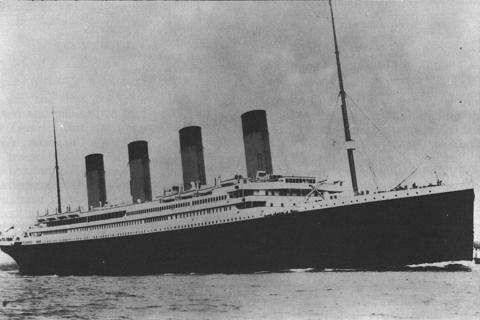The scandal of the Titanic

Senan Moloney's book on the Titanic rigorously questions the scandal of the Mount Temple which allegedly sailed away from the sinking cruise-liner. By Justin Frewen.
On the night of 14th April, 1912, an iceberg ripped through the side of the Titanic. Less than three hours later, the Titanic sank to the bottom of the sea with the loss of over 1,500 lives. The doomed voyage of the Titanic and descent to its final watery resting place have been subject to countless books, reports, articles and studies. Numerous websites have also been devoted to the Titanic including, for instance, Encyclopedia Titanica, to which the author of Titanic Scandal, Senan Molony, has contributed extensively.
While many may be aware of the dramatic dash to rescue on the part of the Carpathia through ice-packed waters, generally less well known was the apparent presence of a mystery ship that idly sat by as the Titanic and its remaining passengers sank below the waves. Almost a century later, the identity of this "mystery" ship remains an issue of heated conjecture and debate.
In both the US and UK inquiries held in the immediate wake of the disaster, testimonies were heard as to the presence of a passive bystander ship, which rather than helping the stricken Titanic's passengers and crew, steamed silently away into the dark night. However, while these inquiries focussed on the likelihood of the SS Californian being the ship in question, Senan investigates the possibility their deliberations were off course.
The author sets up his stall in the form of a juridical examination which looks at ascertaining the guilt or innocence of the Mount Temple and, in particular, its captain James H. Moore.
Senan engages in an exhaustive analysis of the evidence provided by Captain Moore at the two testimonies together with the numerous interviews he provided at the time. Arising from these investigations, Senan points to several inconsistencies in the captain's accounts as well as a number of implausible contestations including, for instance, his attempts to explain the speed at which the Mount Temple travelled in the direction of the Titanic's distress calls as well as his reported positions.
Of further concern are irregularities such as the absence of any record regarding the Titanic in the ship's logs. There is also a puzzling lack of attempted communication on the part of the Mount Temple with other rescue ships and the Titanic itself. Of particular import in this respect was the failure on the part of the Mount Temple to alert other ships proceeding to the aid of the Titanic as to the erroneous information the Titanic had originally provided as to its location.
In addition, the testimonies of certain passengers and crew members on the Mount Temple are scrutinised. Although it is not possible to uncover conclusive proof as to whether the Mount Temple was in fact the mystery ship, their accounts provide strong circumstantial evidence. Furthermore, the fact that a witness such as Quitzrau, a passenger whose statements contradicted Captain Moore´s version on a number of counts, was not called to testify in person at the US inquiry is lamented by the author.
Other circumstantial evidence adumbrated by Senan includes the relatively large-scale desertion by several crew members of the Mount Temple upon its arrival in Canada. Perhaps most condemning of all was the extensive dissembling engaged in by Captain Moore including his claim to have perhaps seen the mystery ship himself, which he was unable to identify despite its close proximity to his own vessel.
While the question might seem relatively simple – was the mystery ship the Mount Temple or not? – its resolution is enormously complex. Not only is there the issue of the length of time that has passed since the sinking of the Titanic, the gaps in critical information and conflicting evidence provided by the main protagonists, investigators also have to grapple with a range of technical conundrums such as the navigational positions and movements of the ships concerned, the reported timings, sightings, distress rockets launched and so forth. Senan displays a mastery of these issues here. However, for the lay reader, who is not an expert in the subject, it is a demanding read. In this respect, it would have been helpful to have navigational charts and other visual references which track, inter alia, the movements, and reported and estimated positions of the Titanic and the other ships in the immediate locality.
A significant plus point for this reader were the copious photographs of the main protagonists, the various ships involved and other relevant elements in the story.
While those who believe strongly that the mystery ship was the Californian may remain disinclined to accept Senan´s case, the questions he raise with respect to the behaviour of the Mount Temple and its captain merit further examination and should, most definitely, not be disregarded out of hand. Senan´s book is an extremely rigorous and detailed analysis and will undoubtedly prove of interest to the large community of Titanic enthusiasts.
Titanic Scandal: The Trial of the Mount Temple by Senan Molony
Publisher: Amberley
